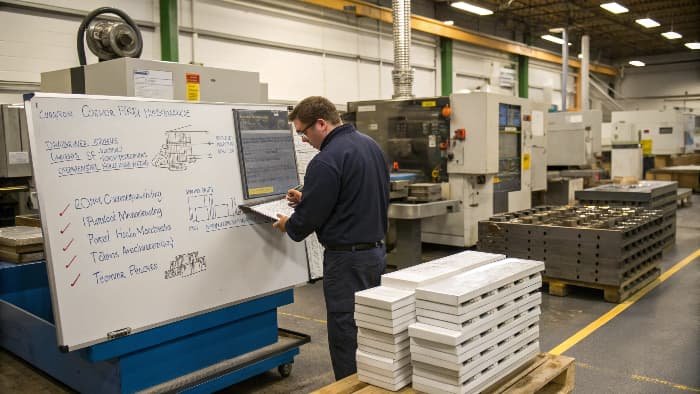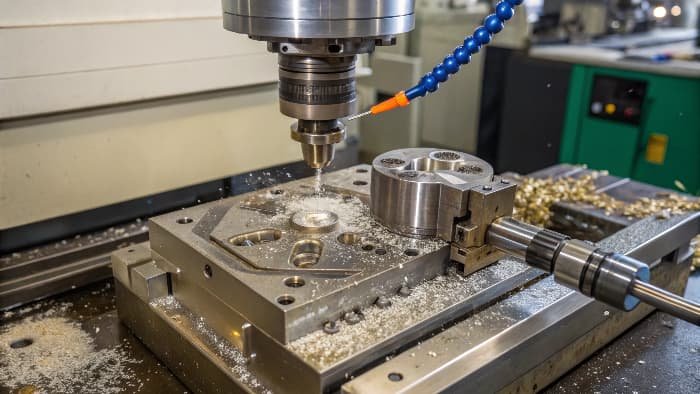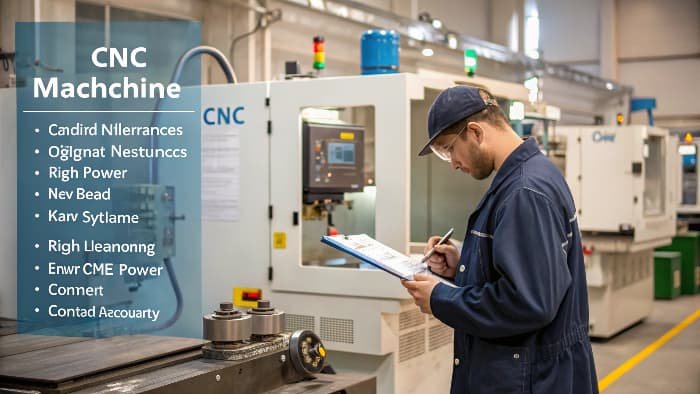Material choice puzzling you? Wrong stock ruins precision. Discover how materials impact your CNC tolerances.
Different materials significantly affect CNC tolerances due to varying physical properties. Harder materials like steel generally hold tighter tolerances than softer plastics. Thermal expansion, flexibility, and moisture absorption also influence dimensional accuracy during and after machining.
Choosing the right material is fundamental. It is not just about strength or appearance. It directly impacts how precisely we can machine your parts. I have seen many projects where material choice was the key to success, and others where it was the main challenge. Let us delve into why this is so critical for achieving the precision your designs demand.
What Exactly Are the Tolerances We Talk About in CNC Machining?
CNC tolerances seem complex? Misunderstanding them leads to bad parts. Let us define these crucial manufacturing limits clearly.
CNC machining tolerances are the allowable variations from a part’s specified dimensions. They define the acceptable range for features. This ensures the part functions correctly and fits within an assembly.
When we discuss tolerances in CNC machining, we are talking about the small, acceptable differences from the exact size shown on a drawing. No machine can create a part perfectly every single time. So, designers specify a range. For example, if a hole needs to be 20mm, a tolerance might be ±0.05mm. This means any hole from 19.95mm to 20.05mm is good. I often explain to engineers like Alex that while very tight tolerances are possible, they are not always needed for every single feature. Knowing where to apply them is important. A bearing needs to fit just right. So, its bore will have a tight tolerance. A simple cover might not need such precision. General tolerances, like those in ISO 2768 (for example, the ‘medium’ or ‘fine’ class), often work well for less critical areas. This gives everyone a common starting point. But for special fits or important surfaces, we need clear instructions on the drawing. These can be plus-or-minus values (like ±0.05mm), or limits (like 20.00mm to 20.10mm). Then, there are geometric tolerances (GD&T). These control the shape and position of features. This helps make sure parts not only fit together but also work correctly, especially in complex machines like robotic arms.
Common Tolerance Types
| Understanding these helps communicate design needs: | Tolerance Type | Description | Example |
|---|---|---|---|
| Dimensional | Controls the size of features (length, width, diameter). | 10.00mm ±0.05mm | |
| Geometric (GD&T) | Controls form, orientation, location of features (flatness, parallelism). | Parallelism within 0.02mm | |
| General | Applied to features without specific callouts (e.g., ISO 2768-mK). | Per standard drawing note |
These types work together to define the part fully.
What Factors Should Be Considered When Selecting Stock Material for CNC Machining and Its Tolerances?
Picking the right material tricky? The wrong choice impacts precision. Learn what to consider for optimal CNC results.
When selecting stock for CNC machining, consider its machinability, thermal stability, hardness, and potential for deformation. These properties directly influence the achievable tolerances and the part’s final dimensional accuracy.

The material you choose to machine has a huge impact on the tolerances we can achieve. It is not just about how strong the final part will be. It is about how the material behaves during the CNC machining process. I remember working with Alex on a project. He initially chose a standard grade of aluminum for a part with thin walls. This aluminum was strong. But it had a lot of internal stress. When we started machining it, the part began to warp. This made it very difficult to keep the ±0.01mm flatness he needed. We talked about it. We decided to switch to a special aluminum alloy that was stress-relieved. This solved the problem. The new material was much more stable during machining. Harder materials, like tool steel, can often be machined to very tight tolerances. But they need slower cutting speeds and stronger tools. Softer materials, like some plastics such as Nylon, can be a bit "gummy." They might bend a little under the cutting tool’s pressure. Some plastics also absorb moisture from the air. This can make them change size slightly after machining. We always have to think about these things.
Key Material Properties Affecting Tolerances:
- Machinability: How easily the material can be cut. Softer materials might cut faster but deform. Harder materials cut slower but can be more dimensionally stable if managed correctly.
- Thermal Expansion: Materials expand when they get hot and shrink when they cool. Machining generates heat. Some materials expand more than others. We need to account for this to hit tight tolerances. For instance, aluminum expands about twice as much as steel for the same temperature change.
- Hardness & Strength: Harder materials resist tool penetration. This can lead to very precise cuts if the machine and tooling are rigid enough. Softer materials might "push away" from the tool.
- Ductility/Brittleness: Ductile materials can deform before they chip. Brittle materials chip easily. This affects surface finish and the ability to hold sharp corners.
- Internal Stresses: Stresses within the raw material (from its manufacturing process) can be released during machining, causing warping. Stress-relieved materials are often better for high-precision parts.
- Moisture Absorption (Plastics): Some plastics absorb moisture from the environment. This can cause them to swell or change dimensions after machining, affecting tolerances over time.
Choosing a material that balances these factors with your functional needs is key.Which Factors Primarily Affect Machining Time and Tolerances When Using CNC Machines?
Worried about long lead times? Several factors influence CNC speed. Understanding them helps optimize production and precision.
Material type and hardness are major factors affecting CNC machining time and achievable tolerances. Complex geometries, tight tolerances themselves, and required surface finish also significantly impact processing duration.

The material being machined is a huge driver of how long a part takes to make. It also affects how well we can hold the tolerances. For example, I once had a job for some complex parts made from copper. Copper is soft and a great conductor. But it can be very sticky to machine. The cutting tools would get material stuck to them if we tried to cut too fast. This meant we had to use slower spindle speeds and feed rates. This made the machining time for each part much longer. To get the tight tolerances needed on some features, we also had to use very sharp, special tools. We took several light cuts instead of one heavy cut. This also added to the time. On the other hand, machining something like free-cutting brass is much quicker. We can run the machines faster. This usually means shorter cycle times for similar parts. So, the material directly tells us what machining strategy to use. That strategy then affects both the time it takes and our ability to consistently hit the precise dimensions required. Tighter tolerances themselves also increase time. We might need more passes, slower feeds, or extra inspection steps.Main Factors and Their Impact:
Factor Impact on Machining Time Impact on Achievable Tolerance Material Hardness Harder = Slower speeds/feeds, more time Can allow tighter tolerances if machine is rigid Material Machinability Poor machinability = Slower, more tool changes Can make tight tolerances challenging Tolerance Tightness Tighter = More passes, slower, more inspection The target itself Part Complexity More features/complex shapes = More time Can make uniform tolerance harder to achieve Surface Finish Finer finish = Slower feeds, extra passes Can be related to dimensional control Tooling Selection Specialized tools may cut slower/faster Correct tooling is vital for precision It is a balance. We always aim for the most efficient way to get the quality you need.
What Key Factors Influence the Selection of CNC Machines for Achieving Desired Tolerances with Specific Materials?
Choosing the right CNC machine crucial? Machine capability affects precision. Learn what influences machine selection for your material and tolerances.
CNC machine selection depends on its rigidity, spindle power and speed, axis accuracy, and control system. These must match the material being machined and the tolerances required for the part.

When Alex, the engineer I often work with, sends us designs for his robotic parts, they are often made from strong steels or special aluminum. These parts usually need very tight tolerances, sometimes down to ±0.01mm. For this kind of work, we have to pick our CNC machines carefully. We use our newer, high-precision machining centers. These machines are built to be very stiff and heavy. This helps stop any vibration when cutting hard materials. Vibrations are bad for accuracy. These machines also have very precise measuring systems on their moving parts. This ensures they position the tool exactly where it needs to be. Their spindles, the part that holds and spins the cutting tool, are powerful. They can run at the specific speeds needed for these tough materials without losing accuracy. If a customer sends a design for a part made from a softer plastic, and the tolerances are not so strict, a different, still capable machine might be fine. It could also be more cost-effective. The machine has to be right for the job. It must suit both the material and the precision needed. It is no good trying to machine hardened tool steel on a light machine if you need tight tolerances. You just will not get the quality.Critical Machine Characteristics:
- Machine Rigidity and Damping: A very stiff machine structure resists bending and absorbs vibrations. This is essential for cutting hard materials accurately and achieving good surface finishes. Less vibration means the tool cuts more consistently.
- Spindle Characteristics: The spindle needs enough power and torque to cut the specific material efficiently without slowing down. The range of available spindle speeds (RPM) is also important. Some materials cut best at high speeds, others at lower speeds.
- Axis Drives and Feedback Systems: High-quality motors and precise feedback systems (like linear scales or rotary encoders) on each machine axis (X, Y, Z) ensure accurate positioning and repeatability. This directly impacts the dimensional accuracy of the machined features.
- Tooling and Workholding Systems: The machine must support appropriate tooling for the material. A robust and accurate tool clamping system is vital. Similarly, the workholding (how the part is held in the machine) must be secure and rigid to prevent movement during machining.
- Control System: A modern CNC controller with advanced features can optimize cutting paths and manage machine movements more effectively, contributing to better accuracy and surface finish.
A machine well-suited to the material and tolerance requirements is a cornerstone of quality CNC machining.Conclusion
Material choice is key for CNC tolerances. Understanding properties like hardness, stability, and machinability helps achieve precision efficiently. Proper selection ensures successful machining outcomes for your parts.


